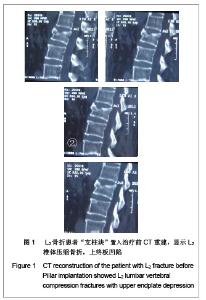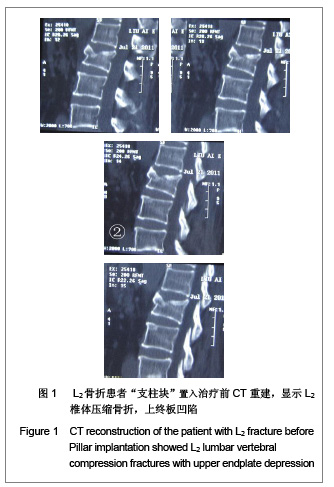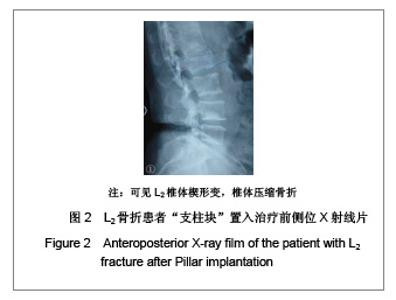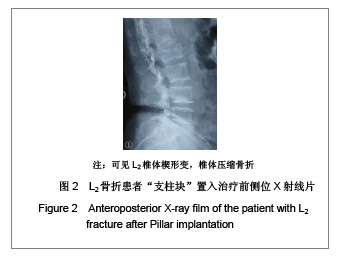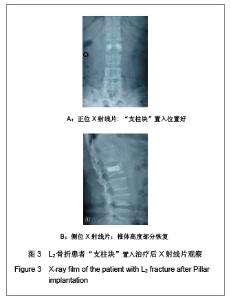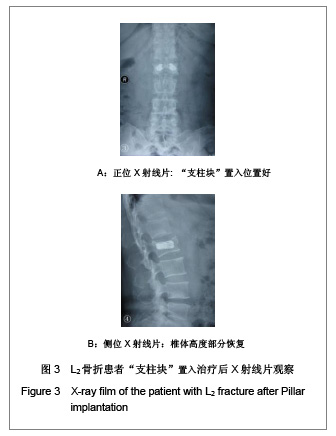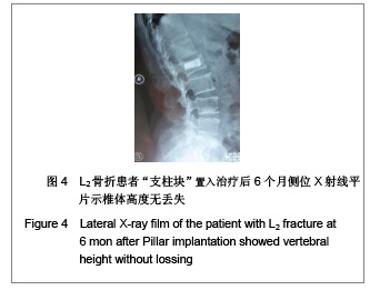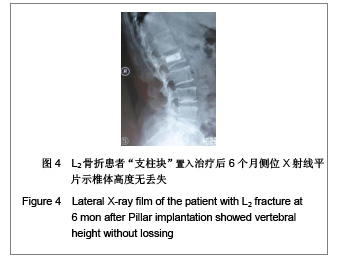Chinese Journal of Tissue Engineering Research ›› 2013, Vol. 17 ›› Issue (9): 1648-1654.doi: 10.3969/j.issn.2095-4344.2013.09.019
Previous Articles Next Articles
Pillar implantation and percutaneous balloon kyphoplasty for the treatment of thoracolumbar vertebral compression fractures
Yu Jin-he, Sun Xian-ze, Ren Liang, Liu Yan-bing, Gu Zhen-fang, Hou Shu-bing
- Yu Jin-he, Sun Xian-ze, Ren Liang, Liu Yan-bing, Gu Zhen-fang, Hou Shu-bing
-
Received:2012-05-29Revised:2012-09-10Online:2013-02-26Published:2013-02-26 -
Contact:Ren Liang, Doctor, Associate chief physician, the Third Hospital of Hebei Medical University, Shijiazhuang 050011, Hebei Province, China Doctorren1973@163.com -
About author:Yu Jin-he, Associate chief physician, the Third Hospital of Hebei Medical University, Shijiazhuang 050011, Hebei Province, China yujinhe999@sina.com
CLC Number:
Cite this article
Yu Jin-he, Sun Xian-ze, Ren Liang, Liu Yan-bing, Gu Zhen-fang, Hou Shu-bing. Pillar implantation and percutaneous balloon kyphoplasty for the treatment of thoracolumbar vertebral compression fractures[J]. Chinese Journal of Tissue Engineering Research, 2013, 17(9): 1648-1654.
share this article
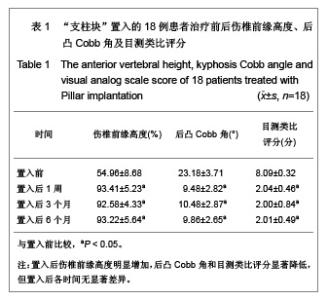
2.1 参与者数量分析 患者随访时间为6-18个月,纳入18例“支柱块”置入患者均进入结果分析。 2.2 “支柱块”置入患者的疗效分析 见表1。18个椎体共置入36枚“支柱块”,手术均顺利,置入后切口无感染,手术切口长度1.5 cm左右,手术时间为50- 80 min,(61.30±5.69) min,置入中失血量为20-50 mL,(28.46±11.23) mL。所有患者置入后均获得随访,随访时间为6-18个月,平均(12.3±3.2)个月,置入后随访的后凸Cobb角、伤椎前缘高度、目测类比评分,与置入前比较,差异均有显著性意义(P < 0.05),置入后均较置入前明显改善,伤椎前缘高度(与相邻椎体高度的百分比)维持满意;置入后各时间点之间比较,差异无显著性意义(P > 0.05)。"
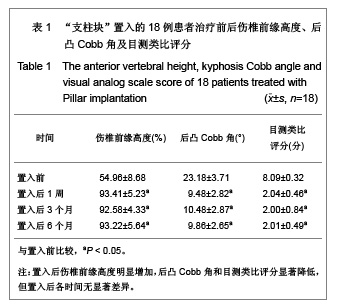
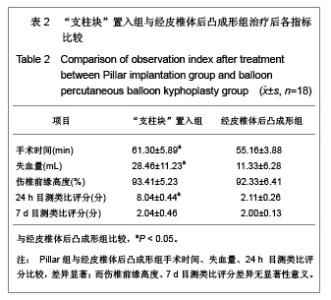
2.4 球囊扩张椎体成形术患者疗效 骨水泥注入76例,92个椎体手术均顺利,术后切口无感染,手术切口长度1.0 cm左右,每个椎体手术时间为40-60(51.16± 3.88)m in,术中失血量为10-20(11.33±6.28) mL。骨水泥渗漏至椎管3例,无神经症状;渗漏至椎间隙5例;渗漏至椎体前方1例;渗漏入椎前静脉丛1例,骨水泥进入椎弓根内2例。所有患者术后均获得随访,随访时间为6-24个月,平均(13.6±4.5)个月,治疗后随访的后凸Cobb角、伤椎前缘高度、目测类比评分。与治疗前比较,差异均有显著性意义(P < 0.05),治疗后均较治疗前明显改善,伤椎前缘高度(与相邻椎体高度的百分比)维持满意;治疗后各时间点之间比较,差异无显著性意义(P > 0.05)。 2.5 “支柱块”置入组与球囊扩张椎体成形组比较 两种治疗方法均顺利,术后切口无感染,手术切口长度相当,”支柱块”置入组与球囊扩张椎体成形组比较,每个椎体手术时间稍长,治疗中失血量稍多,疼痛缓解时间稍长约1周左右,差异均有显著性意义(P < 0.05),无固定物的脱出、移位等,后凸Cobb角、伤椎前缘高度等恢复比较,差异无显著性意义(P > 0.05),见表2。"

| [1] Kado DM, Browner WS, Palermo L, et al. Vertebral fracture and mortality in olderwomen: a prospective study. Arch Intern Med. 1999;159(11):1215-1220.[2] Lieberman IH, Dudeney S, ReinhardtMK, et al. Initial outcome and efficacy of“kyphoplasty”in the treatment ofpainful osteoporotic vertebral compression fractures. Spine J. 2001; 26(14):1631-1638.[3] Qiu MC. Zhonghua Yixue Zazhi. 2001;81(14):833-835. 邱明才.骨质疏松研究的现状与展望[J].中华医学杂志,2001, 81(14):833-835. [4] Liu ZH, Zhang L, Gao LB,et al. Zhonghua CHuangshang Guke Zazhi. 2012;14(6):507-512. 刘振华,张亮,高梁斌,等.胸腰段重度楔形骨质疏松性椎体压缩骨折的经皮椎体成形术治疗与保守治疗的近期疗效和并发症的比较[J].中华创伤骨科杂志,2012,14(6):507-512.[5] Rampersaud YR,Annand N,Dekutoski MB. Use of minimally invasive surgical techniques in the management of thoracolumbar trauma: current concepts. Spine J.2006;31 (11 Suppl):S96-102; discussion S104.[6] Young C, Munk PL, Heran MK, et al.Treatent of severe vertebral body compression fractures with percutaneous vertebroplasty. Skeletal Radiol. 2011;40(12):1531-1536.[7] MeGirt MJ, Parker SL, Wolinsky JP, et al. Vertebroplasty and Kyphoplasty for the treatment of vertebral compression fractures: an evidenced base dreview of the literature. Spine J. 2009;9(6):501-508. [8] Galibert P, Deramond H, Rosat P, et al. Preliminary note on the treatment of vertebral angioma by percutaneous acrylic vertebroplasty. Neurochirurgie. 1987;33(2):66-168. [9] Xie XY,Li PS, Li YM, et al. Zhongguo Jiaoxing Waike Zazhi. 2008;16(6):467-468. 谢晓勇,李平生,李玉茂,等.骨质疏松性脊柱多发性骨折后凸成形术近期疗效分析[J].中国矫形外科杂志,2008,16(6):467-468.[10] Yu JH, Sun XZ, Hou SB, et al. Zhongguo Jiaoxing Waike Zazhi. 2011;19(14):1158-1162. 于金河,孙先泽,侯树兵,等.过伸复位结合椎体后凸成形术治疗后壁破裂的骨质疏松性椎体骨折[J].中国矫形外科杂志,2011, 19(14):1158-1162.[11] Hulme Pa, Krebs J, Ferguson SJ, et al. Vertebroplasty and kyphoplasty: a systematic review of 69 clinical studies. Spine J. 2006;31(17):1983-2001. [12] Yang F, Tang M, Xu KY, et al. Shiyong Guke Zazhi. 2012; 18(6):484-485. 杨峰,唐淼,许康永,等. 椎体后凸成形术治疗骨质疏松性胸腰椎压缩性骨折[J].实用骨科杂志,2012,18(6):484-485.[13] Li SG, Tao H, Li JJ, et al. Zhongguo Jiaoxing Waike Zazhi. 2009;17(2),98-101. 李绍刚,陶海,李建军,等.球囊扩张与Sky扩张后凸成形术的对比研究[J].中国矫形外科杂志,2009,17(2),98-101.[14] Zhang N, Yin GY, Shen GW. SHiyong Laonian Yixue. 2010; 27(5):367-372. 张宁,殷国勇,沈国蔚.椎体内复位扩张器在经皮后凸成形术治疗中的研究现状[J].实用老年医学2010,27(5):367-372.[15] Yin GY, Zhang ZT, Zhang N, et al. Zhongguo Jizhu Jisui Zazhi. 2012;20(9):711-715. 殷国勇,张子韬,张宁,等.应用Jack椎体扩张器行后椎体凸成形术治疗骨质疏松性胸腰椎压缩骨折[J].中国脊柱脊髓杂志,2012, 20(9);711-715.[16] Gaitanis IN, Hadjipavlou AG, Katonis PG, et al.Balloon kyphoplasty for the treatment of pathological vertebral compression fractures. Eur Spine J. 2005; 14(3):250-260.[17] Lin FH, Yi XB, Ren ZH, et al. Zhongguo Gu yu Guanjie Sunshang Zazhi. 2009;24(1):66-67. 蔺福辉,易小波,任志宏,等.高粘度骨水泥在经皮椎体成形术中的应用[J].中国骨与关节损伤杂志,2009,24(1):66-67.[18] Li B, Yu Y, Zhong B, et al. Zhonghua Chuangshang Guke Zazhi. 2010;12(6):486-488. 李波,余雨,钟斌,等.高压分步注射骨水泥选择性经皮椎体成形术治疗骨质疏松性多发椎体骨折[J].中华创伤骨科杂志,2010, 12(6):486-488.[19] Manson NA, Phillips FM. Minimally invasive techniques for the treatment of osteoporotic vertebral fractures. Instr Course Lect. 2007;56:273-285.[20] Sun G, Jin P, Yi YH. Jieru Fangshexue Zazhi. 2006;15(7): 410-412. 孙钢,金鹏,易玉海.椎体后凸成形术治疗老年骨质疏松性椎体压缩骨折[J].介入放射学杂志,2006,15(7):410-412. [21] Fang XH, Ding LH, Fan YL,et al. Zhongguo Jizhu Jisui Zazhi. 2011;21(11):890-894. 方晓辉,丁亮华,樊友亮,等.微创经椎弓根前柱植骨支柱快植入治疗胸腰椎压缩骨折[J].中国脊柱脊髓杂志,2011,21(11):890-894.[22] Jiang ST, Ding LH, Zhu XG, et al. Zhongguo Yishi Jinxiu Zazhi. 2010;33(32):50-52. 姜世涛,丁亮华,朱小广,等.联合椎弓根钉椎体支柱块治疗胸腰椎骨折20例短期疗效分析[J].中国医师进修杂志,2010,33(32): 50-52.[23] Jiang ST,Zhang LZ, Ding LH, et al. Zhongguo Gu yu Guanjie Sunshang Zazhi. 2012;27(3):241-242. 姜世涛,张洛舟,丁亮华,等.支柱块治疗胸腰椎骨折24例临床疗效分析[J].中国骨与关节损伤杂志,2012,27(3):241-242.[24] Jiang ST, Ding LH, Zhang LZ, et al. Zhongguo Jizhu Jisui Zazhi. 2012;22(5):470-471. 姜世涛,丁亮华,张洛舟,等.椎体内置入支柱块联合椎弓根螺钉固定治疗胸腰椎爆裂骨折[J].中国脊柱脊髓杂志,2012,22(5): 470-471.[25] Hu YS, Ma Y, Tian HZ,et al. Zhongguo Jiaoxing Waike Zazhi. 2007;15(18):1392-1394. 胡永胜,马原,田慧中,等.经皮椎体成形术的临床应用[J]. 中国矫形外科杂志,2007,15(18):1392-1394.[26] Yu W. Zhonghua Guzhi Susong He Gukuangyan Jibing Zazhi. 2010;3(2):141-148. 余卫.国际临床骨测量学会2007年骨测量文件简介[J].中华骨质疏松和骨矿盐疾病杂志,2010,3(2):141-148.[27] Yang HL, Wang GL, Niu GQ, et al. Zhonghua Chuangshang Guke Zazhi. 2007;9(8):760-762. 杨惠林,王根林,牛国旗,等.球囊扩张椎体后凸成形术治疗骨质疏松椎体骨折骨不愈合[J].中华创伤骨科杂志,2007,9(8):760-762.[28] Lin WC, Lee YC, Lee CH, et al.Refractures in cemented vertebrate after percutaneous vertebroplasty: a retrospective analysis. Eur Spine J. 2008;17(4):592-599. [29] Ledlie JT, Renfro MB. kyphoplasty treatment of vertebral fractures:2-year outcomes show sustained benefits. 2006; 31(1):57-64.[30] Baroud G, Nemes J, Heini P, et al. Load shift of the intervertebral disc after a vertebroplasty: a finite-element study. Eur Spine J. 2003;12(4):421-426.[31] Liv HZ, Zhao F, Cao J, et al. ZHongguo Xiufu Chongjian Waike Zazhi. 2012;26(12):1419-1421. 吕辉照,赵枫,曹杰,等.椎间盘镜下后路椎管减压联合椎体支柱块治疗胸腰椎陈旧性骨折[J].中国修复重建外科杂志,2012,26(12): 1419-1421.[32] Tian HZ. Zhongguo Jiaoxing Waike Zazhi. 2003;11(18): 1231-1234. 田慧中.椎体间撑压系统加立柱植骨治疗胸腰椎压缩骨折失稳[J].中国矫形外科杂志,2003,11(18):1231-1234.[33] Liu XJ, WangJ, Liu YZ, et al. Zhongguo Guy u Guanjie Sunshang Zazhi. 2012;27(1):41-42. 刘喜俊,王健,刘颖赵,等. Pillar结合后路椎弓根内固定治疗胸腰段椎体骨折[J]. 中国骨与关节损伤杂志,2012,27(1):41-42.[34] Nieuwenhuijse MJ, Putter H, van Erkel AR, et al. New Vertebral Fractures after Percutaneous Vertebroplasty for Painful Osteoporotic Vertebral Compression Fractures: A Clustered Analysis and the Relevance of Intradiskal Cement Leakage. Radiology. 2012 Nov 30. [35] Yoo CM, Park KB, Hwang SH, et al. The analysis of patterns and risk factors of newly developed vertebral compression fractures after percutaneous vertebroplasty. J Korean Neurosurg Soc. 2012;52(4):339-345.[36] Fernández-Baíllo N, Sánchez Márquez JM, Sánchez Pérez-Grueso FJ, et al. Proximal junctional vertebral fracture-subluxation after adult spine deformity surgery. Does vertebral augmentation avoid this complication? A case report. Scoliosis. 2012;7(1):16. |
| [1] | Lu Dezhi, Mei Zhao, Li Xianglei, Wang Caiping, Sun Xin, Wang Xiaowen, Wang Jinwu. Digital design and effect evaluation of three-dimensional printing scoliosis orthosis [J]. Chinese Journal of Tissue Engineering Research, 2021, 25(9): 1329-1334. |
| [2] | Li Dadi, Zhu Liang, Zheng Li, Zhao Fengchao. Correlation of total knee arthroplasty efficacy with satisfaction and personality characteristics [J]. Chinese Journal of Tissue Engineering Research, 2021, 25(9): 1346-1350. |
| [3] | Wei Wei, Li Jian, Huang Linhai, Lan Mindong, Lu Xianwei, Huang Shaodong. Factors affecting fall fear in the first movement of elderly patients after total knee or hip arthroplasty [J]. Chinese Journal of Tissue Engineering Research, 2021, 25(9): 1351-1355. |
| [4] | Lü Zhen, Bai Jinzhu. A prospective study on the application of staged lumbar motion chain rehabilitation based on McKenzie’s technique after lumbar percutaneous transforaminal endoscopic discectomy [J]. Chinese Journal of Tissue Engineering Research, 2021, 25(9): 1398-1403. |
| [5] | Huang Dengcheng, Wang Zhike, Cao Xuewei. Comparison of the short-term efficacy of extracorporeal shock wave therapy for middle-aged and elderly knee osteoarthritis: a meta-analysis [J]. Chinese Journal of Tissue Engineering Research, 2021, 25(9): 1471-1476. |
| [6] | Gao Yan, Zhao Licong, Zhao Hongzeng, Zhu Yuanyuan, Li Jie, Sang Deen. Alteration of low frequency fluctuation amplitude at brain-resting state in patients with chronic discogenic low back pain [J]. Chinese Journal of Tissue Engineering Research, 2021, 25(8): 1160-1165. |
| [7] | Tang Hui, Yao Zhihao, Luo Daowen, Peng Shuanglin, Yang Shuanglin, Wang Lang, Xiao Jingang. High fat and high sugar diet combined with streptozotocin to establish a rat model of type 2 diabetic osteoporosis [J]. Chinese Journal of Tissue Engineering Research, 2021, 25(8): 1207-1211. |
| [8] | Li Zhongfeng, Chen Minghai, Fan Yinuo, Wei Qiushi, He Wei, Chen Zhenqiu. Mechanism of Yougui Yin for steroid-induced femoral head necrosis based on network pharmacology [J]. Chinese Journal of Tissue Engineering Research, 2021, 25(8): 1256-1263. |
| [9] | Liu Zhengpeng, Wang Yahui, Zhang Yilong, Ming Ying, Sun Zhijie, Sun He. Application of 3D printed interbody fusion cage for cervical spondylosis of spinal cord type: half-year follow-up of recovery of cervical curvature and intervertebral height [J]. Chinese Journal of Tissue Engineering Research, 2021, 25(6): 849-853. |
| [10] | Zhao Zhongyi, Li Yongzhen, Chen Feng, Ji Aiyu. Comparison of total knee arthroplasty and unicompartmental knee arthroplasty in treatment of traumatic osteoarthritis [J]. Chinese Journal of Tissue Engineering Research, 2021, 25(6): 854-859. |
| [11] | Zhang Nianjun, Chen Ru. Analgesic effect of cocktail therapy combined with femoral nerve block on total knee arthroplasty [J]. Chinese Journal of Tissue Engineering Research, 2021, 25(6): 866-872. |
| [12] | Hou Guangyuan, Zhang Jixue, Zhang Zhijun, Meng Xianghui, Duan Wen, Gao Weilu. Bone cement pedicle screw fixation and fusion in the treatment of degenerative spinal disease with osteoporosis: one-year follow-up [J]. Chinese Journal of Tissue Engineering Research, 2021, 25(6): 878-883. |
| [13] | Wu Gang, Chen Jianwen, Wang Shilong, Duan Xiaoran, Liu Haijun, Dong Jianfeng. Simple HyProCure subtalar stabilization in treatment of adolescent flexible flatfoot combined with painful accessory navicular bone [J]. Chinese Journal of Tissue Engineering Research, 2021, 25(6): 901-905. |
| [14] | Li Shibin, Lai Yu, Zhou Yi, Liao Jianzhao, Zhang Xiaoyun, Zhang Xuan. Pathogenesis of hormonal osteonecrosis of the femoral head and the target effect of related signaling pathways [J]. Chinese Journal of Tissue Engineering Research, 2021, 25(6): 935-941. |
| [15] | Li Yan, Wang Pei, Deng Donghuan, Yan Wei, Li Lei, Jiang Hongjiang. Electroacupuncture for pain control after total knee arthroplasty: a meta-analysis [J]. Chinese Journal of Tissue Engineering Research, 2021, 25(6): 957-963. |
| Viewed | ||||||
|
Full text |
|
|||||
|
Abstract |
|
|||||
